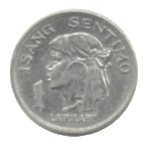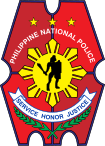Lapulapu facts for kids
Quick facts for kids Lapulapu |
|
|---|---|
| Datu of Mactan | |
| Reign | fl. 1521 |
| Successor | Rajah humabon |
| Born | Mactan, Cebu |
Lapulapu (also spelled Lapu-Lapu) was a brave leader, known as a datu (chief), from the island of Mactan in the Visayas region of the Philippines. He is famous for leading his warriors to victory in the Battle of Mactan. This important battle happened at dawn on April 27, 1521.
In this battle, Lapulapu and his men defeated the Spanish forces. These forces were led by the Portuguese explorer Ferdinand Magellan. Magellan was trying to sail around the world. His death in Mactan stopped his journey. It also delayed Spain's plan to take over the islands for more than 40 years.
Today, many people in the Philippines see Lapulapu as the first Filipino hero. He stood up against the Spanish who wanted to colonize the islands. Statues of Lapulapu are built across the Philippines to honor his courage. Even the Philippine National Police and the Bureau of Fire Protection use his image on their official seals.
Not much is known for sure about Lapulapu's life. The main source of information is from Antonio Pigafetta. He was a diarist who traveled with Magellan. Historians say that no European who wrote about Magellan's trip ever saw Lapulapu or heard him speak. His exact name, where he came from, his religion, and what happened to him are still discussed today.
Contents
Lapulapu's Name
The first time Lapulapu's name was written down was by Antonio Pigafetta. He was with Magellan's expedition. Pigafetta wrote down the names of two chiefs from the island of Mactan: Zula and Çilapulapu. Pigafetta's notes are the only clear original source that mentions Lapulapu by name.
Over time, the name changed. In 1890, José Rizal wrote it as Si Lapulapu. In Filipino languages, "Si" is used before a person's name. So, people thought "Si Lapulapu" meant "He is Lapulapu." The "Si" was later dropped, making the name "Lapulapu" or "Lapu-Lapu" common.
Some historians think the "Si" or "Çi" in his name might have been an old honorary title. It could have come from the Sanskrit word Sri, which means "noble" or "respected."
In 2019, the National Historical Commission of the Philippines said that "Lapulapu" without a hyphen is the correct spelling. This is based on Pigafetta's original writing. In 2021, Philippine President Rodrigo Duterte signed an order. This order officially changed the name to "Lapulapu" for all government and non-government uses.
Early Life and Stories
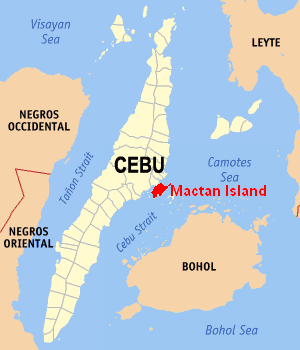
There are many old stories about where Lapulapu came from. One story says that the people of Opong (now Mactan) were first ruled by a datu named Mangal. His son, Lapulapu, then became the leader.
Another story comes from a book called Aginid, Bayok sa Atong Tawarik. This book was published in 1952. It claims to tell the old stories from the time of Rajah Tupas, the last king of Cebu. However, historians are not sure if these stories are completely true.
According to the Aginid story, Lapulapu (called Lapulapu Dimantag) arrived in Cebu from "Borneo." He asked Rajah Humabon, the king of Cebu, for a place to live. Humabon offered him the area of Mandawili (now Mandaue) and the island of Opong (Mactan). Humabon hoped Lapulapu's people would farm the land.
At first, Lapulapu and Humabon had a good relationship. But later, their relationship became difficult. The Aginid says Lapulapu started raiding merchant ships near Opong. This affected trade in Sugbo (Cebu). Because of these raids, the island became known as Mangatang, which means "those who lie in wait." This name later changed to "Mactan."
The Battle of Mactan
Lapulapu was one of the two main leaders of Mactan when the Spanish arrived. The other leader was Zula. Zula agreed to pay tribute to the Spanish king, but Lapulapu refused.
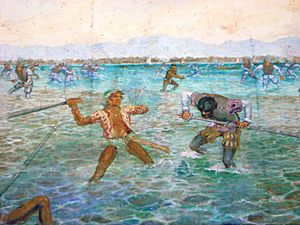
On April 27, 1521, Magellan led about 60 Spanish soldiers. He also had 20 to 30 war boats with warriors from Humabon's group. They arrived at Mactan before dawn. But Magellan's ships could not get close to the shore because of rocks and coral reefs. They had to anchor far away.
According to Antonio Pigafetta, Lapulapu's warriors numbered around 1,500. They had iron swords, bows, and bamboo spears. Magellan offered not to attack if Lapulapu would promise loyalty to Rajah Humabon and the Spanish king. Lapulapu again said no.
The battle started in the morning. Magellan, perhaps wanting to show off European weapons, told Humabon's warriors to stay on their ships. Magellan and 49 Spanish soldiers, wearing heavy armor, went ashore. They had lances, swords, crossbows, and muskets. They tried to scare Lapulapu's men by setting fire to some houses. But this only made Lapulapu's warriors angry, and they charged.
Two Spaniards were killed right away. Magellan was wounded in the leg by a poisoned arrow. He ordered a retreat, but many of his men stayed to protect him. The native warriors recognized Magellan as the leader and focused their attack on him. Magellan's forces were outnumbered and slowed down by their heavy armor. Magellan and several of his men were killed. The rest escaped back to their ships.
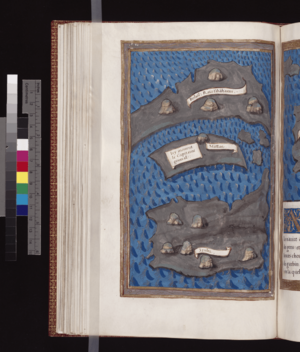
Historian William Henry Scott believed Magellan might have misunderstood how Filipino society worked. Magellan thought that Rajah Humabon, as "king" of Cebu, also ruled Mactan. But Visayan societies were more like a group of independent city-states. The most powerful leader had limited power over other leaders.
Mactan, ruled by Lapulapu and Zula, was in a good spot to stop trade ships going to Cebu. This means Lapulapu might have been more powerful than Humabon. Lapulapu reportedly said he would not bow down to someone he had been commanding for a long time.
After Magellan's death, his remaining ships, the Trinidad and the Victoria, sailed to the Spice Islands. The Victoria continued west and completed the first trip around the world in 1522. Spain later sent more expeditions to the Philippines. The expedition led by Miguel López de Legazpi in 1564 was successful. It led to Spain colonizing the islands.
According to the Aginid story, Lapulapu and Humabon became friends again after the battle. It says Lapulapu later went back to Borneo with his family and men. No one knows for sure what happened to him after that.
Lapulapu's Religion
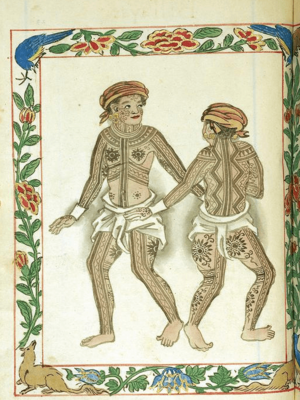
Historians debate Lapulapu's religion. Many believe he followed the local animistic anito beliefs. This means he believed in spirits in nature and ancestors. Some people from the Sulu Archipelago claim Lapulapu was a Muslim. However, many historians disagree with this.
At the time the Spanish arrived, most Cebuanos were animists. They were known for their many tattoos. This is why the Spanish called them Pintados, meaning "painted ones." Pigafetta wrote that Rajah Humabon was tattooed. Things like tattoos, eating pork, and drinking alcohol are forbidden in Islam.
The main god of the Visayans was called Abba by Pigafetta. There is no mention of Islam in these early accounts. Pigafetta clearly called the Cebuanos "heathens" (meaning non-Christians), not "Moros" (his term for Muslims). He wrote:
We set up the cross there for those people were heathen. Had they been Moros, we would have erected a column there as a token of greater hardness, for the Moros are much harder to convert than the heathen.
– Antonio Pigafetta, Primo viaggio intorno al mondo, c. 1525
Another story from the Aginid says Lapulapu might have come from Borneo. It calls him an orang laut ("man of the sea"). But local stories from Mactan say his father was Datu Mangal of Mactan. This suggests Lapulapu was a native of Opong (Mactan).
Lapulapu's Legacy
Recognized as a Filipino Hero
Lapulapu is seen as the first Filipino hero. He is honored for fighting against foreign rule.
On April 27, 2017, President Rodrigo Duterte declared April 27 as Lapu-Lapu Day. This day honors him as the first hero of the country. President Duterte also created the Order of Lapu-Lapu. This award recognizes people who help the country.
Senator Richard Gordon also suggested making April 27 a national holiday. It would be called Adlaw ni Lapu-Lapu, which means "Day of Lapu-Lapu" in Cebuano.
Commemorations
The government built a statue to honor Lapulapu on Mactan Island. They also renamed the town of Opon in Cebu to Lapu-Lapu City. A large statue of him, given by South Korea, stands in Rizal Park in Manila.
Lapulapu's image is on the official seal of the Philippine National Police. His face was also on the 1-centavo coin in the Philippines from 1967 to 1994.
In the United States, a street in San Francisco is named after Lapulapu. This street and others were renamed in 1979 to honor Filipino heroes.
In 2021, the Bangko Sentral ng Pilipinas (Central Bank of the Philippines) released a special 5,000-Piso banknote. This non-circulating banknote honors Lapulapu's bravery.
In Urban Legend and Folklore
Local legends say that Lapulapu never died. Instead, he turned into stone and now guards the seas around Mactan. Fishermen in Mactan sometimes throw coins at a man-shaped stone. They do this to "ask permission" from Lapulapu to fish in his waters.
Another legend is about a statue of Lapulapu built in 1933 in Lapu-Lapu City. The statue showed Lapulapu with a crossbow. Superstitious citizens wanted to change the crossbow to a sword. This was because three mayors of Opon (the old name for Lapu-Lapu City) died of heart attacks. The statue was changed in 1938.
In Popular Culture
- Lapulapu has been played by actors in films. Mario Montenegro played him in the 1955 film Lapu-Lapu.
- Lito Lapid played him in the 2002 film Lapu-Lapu.
- He was also a character in the children's educational series Bayani in 1995.
- Lapulapu inspired a playable character in the mobile game Mobile Legends: Bang Bang. This character is a dual swordsman and chief of Makadan, which is a reference to Mactan Island.
- The song "Panalo" by Ez Mil mentioned Lapulapu.
Shrine
The Lapu-Lapu shrine is a 20 meters (66 ft) bronze statue. It is located in Punta Engaño, Lapu-Lapu City, Cebu, Philippines.
See also
 In Spanish: Lapulapu para niños
In Spanish: Lapulapu para niños


